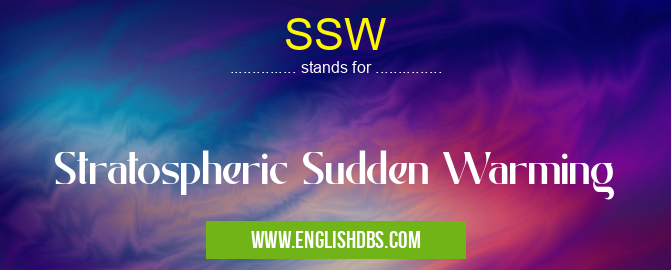What does SSW mean in ENVIRONMENTAL
SSW (Stratospheric Sudden Warming) is a meteorological phenomenon that occurs in the Earth's stratosphere, the atmospheric layer above the troposphere. It involves a rapid increase in temperature in the stratosphere, typically over the polar regions, leading to a disruption of the normal stratospheric circulation.

SSW meaning in Environmental in Governmental
SSW mostly used in an acronym Environmental in Category Governmental that means Stratospheric Sudden Warming
Shorthand: SSW,
Full Form: Stratospheric Sudden Warming
For more information of "Stratospheric Sudden Warming", see the section below.
Meaning in Government and Governance
SSW is not typically used in the context of government or governance.
Full Form and Meaning
- Stratospheric Sudden Warming
What Does SSW Stand For?
- SSW stands for Stratospheric Sudden Warming.
Explanation
SSW events typically occur during the winter months and are characterized by:
- A rapid increase in stratospheric temperatures over the polar regions, often by 50-60°C (90-110°F) within a few days.
- A reversal of the normal stratospheric wind direction, from westerly to easterly.
- A weakening or disruption of the polar vortex, a large-scale atmospheric circulation pattern that normally confines cold air to the polar regions.
SSW events can have significant impacts on the tropospheric circulation, including:
- Changes in jet stream patterns, which can affect weather conditions in mid-latitude regions.
- Disruption of the North Atlantic Oscillation, a climate pattern that influences winter weather in Europe.
- Extreme weather events, such as cold spells or heavy precipitation.
Essential Questions and Answers on Stratospheric Sudden Warming in "GOVERNMENTAL»ENVIRONMENTAL"
What is Stratospheric Sudden Warming (SSW)?
SSW is a meteorological phenomenon that involves a rapid warming of the stratosphere, the atmospheric layer above the troposphere. It is characterized by a reversal of the normal temperature gradient, where the stratosphere becomes warmer than the troposphere below.
What causes Stratospheric Sudden Warming?
SSWs are primarily triggered by the propagation of planetary waves from the troposphere into the stratosphere. These waves can be generated by weather systems such as cyclones and anticyclones. When the waves reach the stratosphere, they can interact with the prevailing winds and cause a disruption in the polar vortex, leading to a warming of the stratosphere.
What are the characteristics of Stratospheric Sudden Warming?
SSWs are characterized by:
- A rapid increase in stratospheric temperatures, often exceeding 50 degrees Celsius.
- A reversal of the normal temperature gradient, with the stratosphere becoming warmer than the troposphere below.
- A disruption of the polar vortex, leading to a weakening and displacement of the high-pressure system that typically resides over the poles.
What are the impacts of Stratospheric Sudden Warming?
SSWs can have significant impacts on weather patterns in the Northern Hemisphere:
- They can disrupt the polar vortex, allowing cold air to escape from the Arctic and cause cold spells in Europe and North America.
- They can influence jet stream patterns, leading to changes in storm tracks and precipitation patterns.
- In some cases, SSWs can even cause the jet stream to split into two branches, resulting in extreme weather events.
How can we predict Stratospheric Sudden Warming?
Predicting SSWs is challenging, but scientists are improving their ability to do so using weather forecasting models. These models simulate atmospheric conditions and can provide early indications of potential SSW events. However, the precise timing and magnitude of SSWs remain difficult to forecast.
Final Words: SSW is a complex meteorological phenomenon that can have important implications for weather and climate. By understanding SSW and its potential impacts, scientists can better predict and mitigate its effects on human society.
SSW also stands for: |
|
| All stands for SSW |
